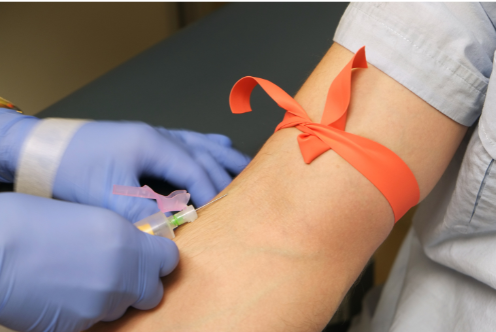Staying Current: Why Yesterday's Training Could Be Today's Liability
The uncomfortable truth about outdated phlebotomy practices and why continuing education isn't optional
by Shanise Keith • August 12, 2025
As some of you may know, along with my other responsibilities as the owner of the Center for Phlebotomy Education, I also work as an expert witness for phlebotomy-related lawsuits. Last month, I was reviewing materials for a phlebotomy injury case when I saw something that unfortunately comes up far too often. The training documents I was examining looked like they'd been pulled straight from a 1990s textbook. Wrong insertion angles, outdated equipment recommendations, and practices that directly contradicted current CLSI standards.
The worst part? This wasn't some dusty manual sitting forgotten on a shelf. These materials were actively being used to train new phlebotomists.
As someone who regularly serves as an expert witness in phlebotomy injury cases, I see the real-world consequences of outdated training more often than I'd like. And here's what I want every educator and trainer to understand: the most common injuries I investigate aren't caused by malicious intent or gross negligence. They're caused by well-meaning professionals who were simply taught the wrong way to do things.

There is a huge problem with “That’s how we’ve always done it.” It runs rampant in many places, and I get it. When you've been drawing blood successfully for years using certain techniques, it's natural to stick with what works. But here's the reality – phlebotomy standards evolve for a reason. Every update to CLSI guidelines, every revision to best practices, represents lessons learned from thousands of procedures and, unfortunately, from injuries that could have been prevented.
Recently, I encountered training materials that recommended outdated information about needle insertion angles, and while it taught the names of the available AC veins, it did not prioritize them according to safety. Some older training materials still recommend practices that we now know increase the risk of going too deep or hitting structures we want to avoid. The science of phlebotomy has advanced – our training should reflect that advancement.
The most frequent types of cases I get are due to nerve injuries. And something that comes up in literally almost every nerve injury case I review involves the basilic vein. The basilic vein sits dangerously close to the median nerve and brachial artery. When phlebotomists don't understand proper vein prioritization – choosing the median cubital first, then the cephalic, and leaving the basilic as a last resort – they put patients at serious risk.
I've seen too many cases where a phlebotomist went straight to the basilic vein because it "looked good" or because they weren't taught the proper order of site selection. The resulting nerve injuries can cause permanent pain, numbness, and loss of function. These aren't theoretical risks – they're real injuries happening to real patients, and they're often completely preventable with proper current training.
Here's what I want to emphasize: if you're reading this and thinking, "Oh no, I was taught some of these outdated methods," that's completely normal and absolutely okay. Goodness knows I have had that revelation myself over the years as new information has come out. Medicine evolves constantly. What matters isn't what you learned five, ten, or twenty years ago – what matters is what you do with new information today. Working in healthcare isn’t about perfection, it’s about growth.
The healthcare professionals I most respect are the ones who regularly question their own practices and seek out current information. They're the ones who admit when they don't know something and who make an effort to stay educated about changes in their field.
On the flip side, the cases that end up in legal trouble often involve practitioners who stopped learning after their initial training. They become comfortable with their routine and resist updates, even when those updates could protect both them and their patients.

When I review injury cases, I'm not just looking at whether someone followed the exact letter of CLSI standards. I'm looking at whether they demonstrated the kind of ongoing professional development that shows they take patient safety seriously. Are they knowledgeable? Do they understand what they are doing? Or are they just following bad advice they got from a coworker, or something they saw online somewhere?
So often in these cases I find out that the phlebotomist has no idea what the names of the veins are, what vein prioritization is, or that hitting a nerve or an artery is even a risk. They may have learned a little bit about it in school (if they even went to school for phlebotomy), but not enough to remember or fully understand how their lack of knowledge increases the chance of those injuries occurring. And their employer doesn’t require them to do continuing education, or provide training materials to keep them up to date.
Courts and juries understand that medicine changes. They don't expect every healthcare professional to be perfect. But they do expect professionals to make reasonable efforts to stay current with accepted practices in their field. When someone is still using techniques that were outdated 10 or 20 years ago, that becomes much harder to defend.
Sometimes the difference between current and outdated practice seems small. A slightly different angle here, a different order of vein selection there, following the current order of draw, avoiding pumping the fist, etc. But these seemingly minor details can mean the difference between a smooth, safe procedure and a life-changing injury.
I've seen cases where a very avoidable decision was the deciding factor in whether a patient walked away unharmed or developed permanent nerve damage. These precision points aren't arbitrary – they're based on anatomical research and thousands of documented procedures.
So how do we stay current? It starts with acknowledging that learning doesn't end with certification. Whether you're a practicing phlebotomist or training others, ongoing education should be non-negotiable.

Review your training materials regularly. When was the last time you updated your curriculum? Are your techniques aligned with current CLSI standards? Do you emphasize proper vein prioritization? Are you teaching the safest, most current methods available?
Consider your facility's protocols as well: Are they updated annually? Do employees have to review them and demonstrate their understanding through testing? Are competency evaluations conducted to ensure that staff understand updates and follow current protocols? Are these employee evaluations documented each time they occur?

Attend workshops, read current literature, participate in professional organizations, and don't be afraid to ask questions when you encounter new information. The medical field rewards curiosity and punishes complacency.
The bottom line? Every time I review a phlebotomy injury case, I'm reminded that the skills we teach and practice have real (and sometimes devastating) consequences. When we stay current with best practices, we protect patients, protect ourselves, and maintain the integrity of our profession.
There's no shame in discovering that some of your training is outdated – there's only opportunity to do better. The question isn't whether you were taught the right way initially. The question is whether you're committed to learning the right way now.
Because in a field where a few millimeters can mean the difference between success and injury, staying current isn't just professional development – it's patient safety. And that's something we all have a responsibility to take seriously.
What steps are you taking to ensure your phlebotomy practices reflect current standards? I'd love to hear about the continuing education resources that have been most valuable to you.
Related Posts and Information
overall rating: my rating: log in to rate
